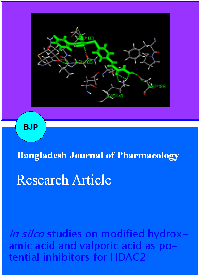In silico studies on modified hydroxamic acid and valporic acid as potential inhibitors for HDAC2
DOI:
https://doi.org/10.3329/bjp.v8i3.15433Keywords:
HDAC2, Hydroxamic acid, Molecular docking, SAHA, Valporic acidAbstract
Histone deacetylases2, Class 1 HDAC family are emerged as an important therapeutic target for the treatment of various cancers. HDAC2 inhibitors are potent anti-cancer agents. Two inhibitors of HDAC2 are hydroxamic acid and valporic acid which are potent inducers of growth arrest, differentiation, and/or apoptotic cell death. Total 34 ligands optimized using triazole group substitution for the target protein Histone deacetylase2 on the basis of SAHA and valporic acid. All the ligands are docked with the target protein and results are compared with test compound SAHA. Eight ligands showed better binding affinity towards HDAC2.The binding affinity, free energy and drug scan screening of the above eight ligands have shown that P2, P6 and V6 molecules are best suitable to inhibit HDAC2.
Downloads
292
235 Read
19
References
Alonso H, Bliznyuk AA, Gready JE. Combining docking and molecular dynamic simulation in drug design. Med Res Rev. 2006; 26: 531-68.
Bhakat S. SAR and pharmacophore based designing of some antimalarial and antiretroviral agents: An internet based drug design approach. Der Pharma Chemica. 2012; 4: 1247-63.
Bieliauskas AV. Pflum MKH. Isoform-selective histone deacetylase inhibitors. Chem Soc Rev. 2008; 37: 1402-13.
Copeland RA. Evaluation of enzyme inhibitors in drug discovery: A guide for medicinal chemists and pharmacologists. New Jersey, Wiley Interscience, 2005.
Lindemann RK, Johnstone RW. Histone deacetylase inhibitors: promising candidates for chemotherapeutic drugs. Gene Ther Mol Biol. 2004; 8: 61-74.
Mai A, Massa S, Ragno R, Esposito M, Sbardella G, Nocca G, Scatena R, Jesacher F, Loidl P, Brosch G. Binding mode analysis of 3-(4-benzoyl-1-methyl-1H-2-pyrrolyl)-N-hydroxy-2-propenamide: A new synthetic histone deacetylase inhibitor inducing histone hyperacetylation, growth inhibition, and terminal cell differentiation. J Med Chem. 2002; 40: 1-13.
Marks PA. Discovery and development of SAHA as an anticancer agent. Oncogene 2007; 26: 1351-56.
Monneret C. Histone deacetylase inhibitors. Eur J Med Chem. 2005; 40: 1-13.
Prince HM, Bishton M. Panobinostat (LBH589): A novel pan-deacetylase inhibitor with activity in T cell lymphoma. Hemat Meet Rep. 2009; 3: 33-38.
Roffey J. Bioisosteres in medicinal chemistry. Maybridge Med Chem. 1997; 1: 23-44.
Walkinshaw DR, Yang XJ. Histone deacetylase inhibitors as novel anticancer therapeutics. Curr Oncol. 2008; 15: 237-43.
Venkatachalam CM, Jiang X, Oldfield T, Waldman M. LigandFit: A novel method for the shape-directed rapid docking of ligands to protein active sites. J Mol Graph Mod. 2003; 21: 289.

Published
How to Cite
Issue
Section
License
Authors who publish with this journal agree to the following terms:
- Authors retain copyright and grant the journal right of first publication with the work simultaneously licensed under a Creative Commons Attribution License that allows others to share the work with an acknowledgement of the work's authorship and initial publication in this journal.
- Authors are able to enter into separate, additional contractual arrangements for the non-exclusive distribution of the journal's published version of the work (e.g., post it to an institutional repository or publish it in a book), with an acknowledgement of its initial publication in this journal.
- Authors are permitted and encouraged to post their work online (e.g., in institutional repositories or on their website) prior to and during the submission process, as it can lead to productive exchanges, as well as earlier and greater citation of published work (See The Effect of Open Access).
